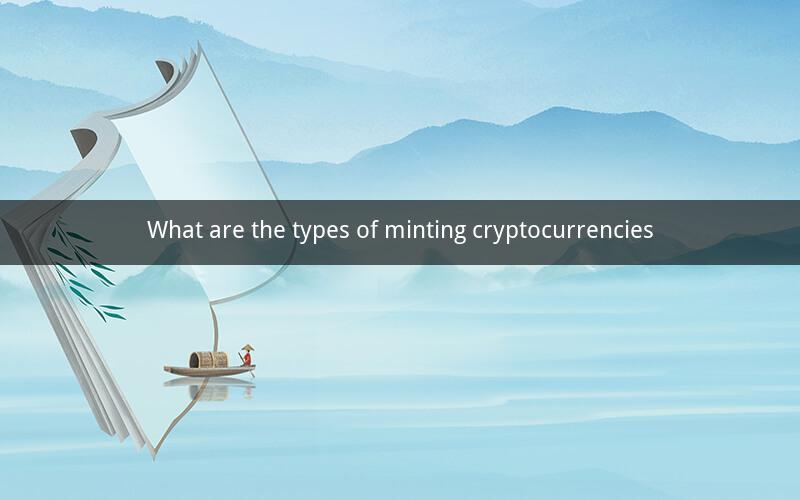
Table of Contents
1. Introduction to Cryptocurrency Minting
2. Understanding the Concept of Minting
3. Types of Cryptocurrency Minting
1. Proof of Work (PoW)
2. Proof of Stake (PoS)
3. Delegated Proof of Stake (DPoS)
4. Proof of Authority (PoA)
5. Proof of Burn (PoB)
6. Proof of Capacity (PoC)
7. Proof of Elapsed Time (PoET)
8. Proof of Space and Time (PoST)
9. Proof of Randomness (PoR)
10. Proof of Human Work (PoHW)
4. Conclusion
1. Introduction to Cryptocurrency Minting
Cryptocurrency minting refers to the process of creating new units of a digital currency. This process is crucial for the functioning of various blockchain networks, as it ensures the supply of new coins and helps maintain the network's security. In this article, we will explore the different types of cryptocurrency minting processes, their workings, and their implications for the blockchain ecosystem.
2. Understanding the Concept of Minting
Minting is akin to mining in the context of cryptocurrencies. While mining is the process of validating transactions and adding them to the blockchain, minting is the creation of new coins. The minting process varies depending on the consensus mechanism employed by a particular cryptocurrency network.
3. Types of Cryptocurrency Minting
The following are some of the most common types of cryptocurrency minting processes:
3.1 Proof of Work (PoW)
Proof of Work (PoW) is one of the earliest consensus mechanisms used in cryptocurrency networks. It requires miners to solve complex mathematical puzzles to validate transactions and create new coins. The first successful cryptocurrency, Bitcoin, uses PoW as its consensus mechanism.
3.2 Proof of Stake (PoS)
Proof of Stake (PoS) is a more energy-efficient alternative to PoW. In PoS, validators are chosen to create new blocks based on the number of coins they hold and are willing to "stake" as collateral. This reduces the need for powerful hardware and decreases energy consumption.
3.3 Delegated Proof of Stake (DPoS)
Delegated Proof of Stake (DPoS) is a variant of PoS where token holders vote for a set of delegates who are responsible for minting new coins. This process allows for faster block creation and improved scalability.
3.4 Proof of Authority (PoA)
Proof of Authority (PoA) is a consensus mechanism where validators are chosen based on their reputation and authority. This mechanism is often used in private and permissioned blockchains due to its efficiency and reduced energy consumption.
3.5 Proof of Burn (PoB)
Proof of Burn (PoB) is a consensus mechanism where users destroy (burn) their existing coins to create new ones. This process reduces the total supply of the cryptocurrency and increases its scarcity, potentially driving up its value.
3.6 Proof of Capacity (PoC)
Proof of Capacity (PoC) is a consensus mechanism where validators demonstrate their storage capacity to mint new coins. This process is energy-efficient and requires less computational power compared to PoW.
3.7 Proof of Elapsed Time (PoET)
Proof of Elapsed Time (PoET) is a consensus mechanism where validators compete to create the next block by generating a random number. The validator with the lowest number wins and gets to create the next block.
3.8 Proof of Space and Time (PoST)
Proof of Space and Time (PoST) is a consensus mechanism that combines PoC and PoET. Validators demonstrate their storage capacity and the duration they have held their coins to mint new ones.
3.9 Proof of Randomness (PoR)
Proof of Randomness (PoR) is a consensus mechanism where validators are chosen based on a random selection process. This mechanism ensures fairness and prevents manipulation of the minting process.
3.10 Proof of Human Work (PoHW)
Proof of Human Work (PoHW) is a consensus mechanism where validators prove that they have performed a certain amount of work to mint new coins. This process is designed to prevent automated mining and ensure that human effort is required.
4. Conclusion
Cryptocurrency minting is a crucial process for the functioning of blockchain networks. The various types of minting processes offer different advantages and trade-offs, making them suitable for different use cases. As the cryptocurrency ecosystem continues to evolve, we can expect to see further advancements in minting technologies and consensus mechanisms.
Questions and Answers
1. What is the difference between PoW and PoS?
- PoW requires miners to solve complex mathematical puzzles, while PoS relies on validators to create new blocks based on the number of coins they hold.
2. How does DPoS differ from PoS?
- DPoS involves token holders voting for a set of delegates to mint new coins, while PoS requires validators to be chosen based on the number of coins they hold.
3. What is the purpose of PoA?
- PoA is used in private and permissioned blockchains to ensure efficiency and reduced energy consumption by choosing validators based on their reputation and authority.
4. How does PoB work?
- PoB requires users to destroy (burn) their existing coins to create new ones, reducing the total supply and potentially increasing the value of the cryptocurrency.
5. What is the main advantage of PoC?
- PoC is energy-efficient and requires less computational power compared to PoW.
6. How does PoET work?
- PoET involves validators competing to create the next block by generating a random number, with the lowest number winning.
7. What is the difference between PoST and PoC?
- PoST combines PoC and PoET, requiring validators to demonstrate their storage capacity and the duration they have held their coins.
8. How does PoR ensure fairness in the minting process?
- PoR uses a random selection process to choose validators, preventing manipulation and ensuring fairness.
9. What is the purpose of PoHW?
- PoHW requires validators to prove that they have performed a certain amount of work to mint new coins, preventing automated mining and ensuring human effort.
10. How do PoS and DPoS compare in terms of scalability?
- DPoS offers better scalability compared to PoS due to its faster block creation and reduced number of validators.